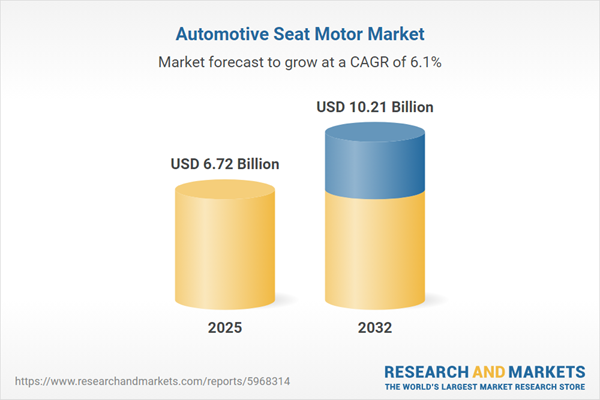Speak directly to the analyst to clarify any post sales queries you may have.
The automotive seat motor market is undergoing a rapid transformation driven by innovations in electrification, connectivity, and sustainability, presenting actionable insights for senior leaders navigating complex supply chains and regulatory landscapes.
Market Snapshot: Automotive Seat Motor Market Growth and Trends
The global automotive seat motor market grew from USD 6.36 billion in 2024 to USD 6.72 billion in 2025 and is projected to achieve a compound annual growth rate (CAGR) of 6.09%, reaching USD 10.21 billion by 2032. This expansion is propelled by a surge in vehicle electrification, sustained advances in comfort and personalization features, and increasing regulatory requirements across major automotive ecosystems.
Scope & Segmentation: Comprehensive Market Coverage
The report provides an extensive evaluation of the automotive seat motor sector by analyzing its most relevant segments, emerging technologies, and geographic dynamics.
- Motor Types: DC motors (brushless and brushed), stepper motors
- Voltage Classifications: 12V-18V, 24V-36V, above 36V
- Functional Roles: Forward & backward slide, headrest adjustment, lumbar support, seat height adjustment, seat recline, seat tilt, side bolster adjustment
- Applications: Commercial vehicles, passenger vehicles
- End Users: Aftermarket, original equipment manufacturers (OEMs)
- Distribution Channels: Offline, online
- Regions: Americas (covering North and Latin America), Europe, Middle East & Africa, Asia-Pacific (including China, India, Japan, and other key markets)
- Companies Analyzed: Adient PLC, AISIN Group, Brose SE, Continental AG, Faurecia SE, Inteva Products, Johnson Electric Holdings, Mabuchi Motor Co., Magna International, MITSUBA Corporation, Nidec Corporation, and others
Key Takeaways: Strategic Insights for Senior Decision-Makers
- The automotive seat motor market is shaped by the rising adoption of smart, modular, and energy-efficient technologies that enhance user experience and vehicle differentiation.
- Regulatory pressures around noise reduction, safety, and recyclability are compelling manufacturers to integrate advanced materials and control systems, altering procurement and R&D priorities.
- Emerging technologies such as brushless DC motor architectures and motor-integrated control modules enable precision seat actuation and support customization for both passenger and commercial vehicle markets.
- Demand for integration with digital systems, including in-car health monitoring and telematics platforms, is generating new value streams and influencing product design strategies.
- Partnerships and alliances across traditional automotive and technology sectors are facilitating joint innovation and establishing standards for digital seat module interoperability.
Tariff Impact: Responding to U.S. Trade Developments
Recent U.S. tariff adjustments have prompted manufacturers to re-examine sourcing strategies, accelerate near-shoring, and consider vertical integration to maintain supply chain flexibility and cost control. These developments have heightened focus on scenario planning, inventory optimization, and supplier diversification as market participants seek to anticipate and minimize operational disruptions.
Methodology & Data Sources
This report utilizes primary research—structured interviews and site visits with OEMs, tier-one suppliers, and regulatory authorities—supplemented by comprehensive secondary research of trade data, public filings, and technical literature. Triangulation across data sources ensures rigor, consistency, and actionable findings for decision-making.
Why This Report Matters
- Enables informed strategic planning to address technological advances, regulatory changes, and evolving market preferences.
- Supports investment justification and risk mitigation through detailed supply chain, segmentation, and geographic analysis.
- Provides actionable recommendations for leaders focused on innovation, compliance, and sustainability in an increasingly complex environment.
Conclusion
The automotive seat motor market is evolving in response to technological, regulatory, and regional shifts. Senior leaders leveraging these insights can align strategies for growth, resilience, and future competitiveness in a rapidly changing sector.
Additional Product Information:
- Purchase of this report includes 1 year online access with quarterly updates.
- This report can be updated on request. Please contact our Customer Experience team using the Ask a Question widget on our website.
Table of Contents
3. Executive Summary
4. Market Overview
7. Cumulative Impact of Artificial Intelligence 2025
Companies Mentioned
The companies profiled in this Automotive Seat Motor market report include:- Adient PLC
- AISIN Group
- Brose SE
- Continental AG
- Faurecia SE
- Inteva Products, LLC by The Renco Group, Inc.
- Johnson Electric Holdings Limited
- Mabuchi Motor Co., Ltd.
- Magna International Inc.
- MITSUBA Corporation
- Nidec Corporation
- Ningbo Chunji Technology Limited
- Robert Bosch GmbH
- Shandong MingAo Automobile Technology Co., Ltd.
- SHB Group
- Shenzhen Power Motor Industrial Co., Ltd.
- Shuanglin Group Co., Ltd.
- Toyota Motor Corporation
- Xiamen Qianze Electronic Technology Co., Ltd.
Table Information
| Report Attribute | Details |
|---|---|
| No. of Pages | 193 |
| Published | November 2025 |
| Forecast Period | 2025 - 2032 |
| Estimated Market Value ( USD | $ 6.72 Billion |
| Forecasted Market Value ( USD | $ 10.21 Billion |
| Compound Annual Growth Rate | 6.0% |
| Regions Covered | Global |
| No. of Companies Mentioned | 20 |









